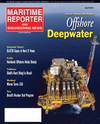
Page 33: of Maritime Reporter Magazine (April 2, 2010)
Read this page in Pdf, Flash or Html5 edition of April 2, 2010 Maritime Reporter Magazine
April 2010 www.marinelink.com 33
The Brazilian Navy´s nuclear program, officially named “Programa Nuclear da
Marinha” (PNM), in Portuguese, began in 1979 with very limited funds and a lot of determination by the Brazilian Navy to see it through. The Program can be di- vided in two parts, the first being to gain experience and knowledge in order to dominate the ultracentrifuge enrichment process for uranium. The Navy estimates it will be able to complete the full ura- nium enrichment process this year.
The second part was to develop and construct a small nuclear plant to gener- ate electric energy for naval propulsion through a pressurized water reactor (PWR). The challenge now is to com- plete the second part, completing the nu- clear plant for naval propulsion. This part is being done at the Nuclear-Electric
Generation Laboratory (LABGENE).
The nuclear reactor also needs to be made operational in a size that fits the hull of the planned nuclear submarine.
Along the 30 years following the first investments, the PNM has seen two dis- tinct phases. The first 10 years of growth, which reached a peak of $90 million in investments in 1989 and the subsequent 16 years of slow decline in investments, eventually reaching a low of less than $20 million in 2005. It is widely known that from 2000 to around 2007, the second phase of the PNM had been in a vegeta- tive state, with investments limited to maintaining the programs in existence without any major gains.
Investments between 1979 and 1990 came from the Brazilian Navy´s yearly budget and from other governmental funds. After 1990 up to around 2007 the investments came solely from the Brazil- ian Navy´s yearly budged, which also de- clined during this period. There was no specific governmental budget related to the PNM. Along many of those years the
PNM went through desperate times, with the Brazilian Naval Command having to skim funds from fleet maintenance and upgrade in order to simply maintain the program in a vegetative state.
We are now entering a third phase, where development investments are guar- anteed, as the PNM is now considered a national interest program by the Brazil- ian government, said President Luis Ina- cio “Lula” da Silva. There is no serious risk to the programs continuity even with the upcoming Presidential elections in
Brazil.
The Brazilian Navy had forecast the need for a budget between 2007-2014 of $1 billion or $130 million per year, in order to complete the PNM program by 2014 and by then have an operational re- actor, sized to fit in a custom made sub- marine hull. The program is based on a nuclear reactor capable of generating 11MW of electricity, thus having the ca- pacity to supply energy to a city with a population of around 20,000, conse- quently proving the concept of producing a nuclear reactor also useful for civilian use. This budget has been guaranteed by the Brazilian government and may even increase if there is proven necessity of extra funds, as the government acknowl- edges the technological advances the
PNM will bring to the country and the strategic importance the PNM has to the
Brazilian Navy and to Brazil. The fact is that the nuclear reactor needs to be oper-
Autonomous submarine energy module. (Photo cr edit DCNS)

 32
32

 34
34
